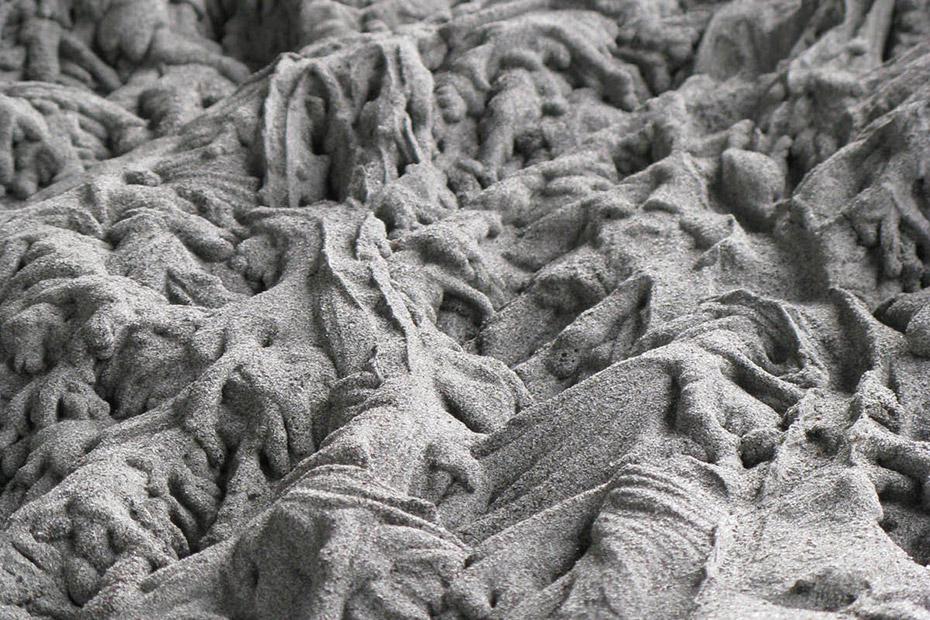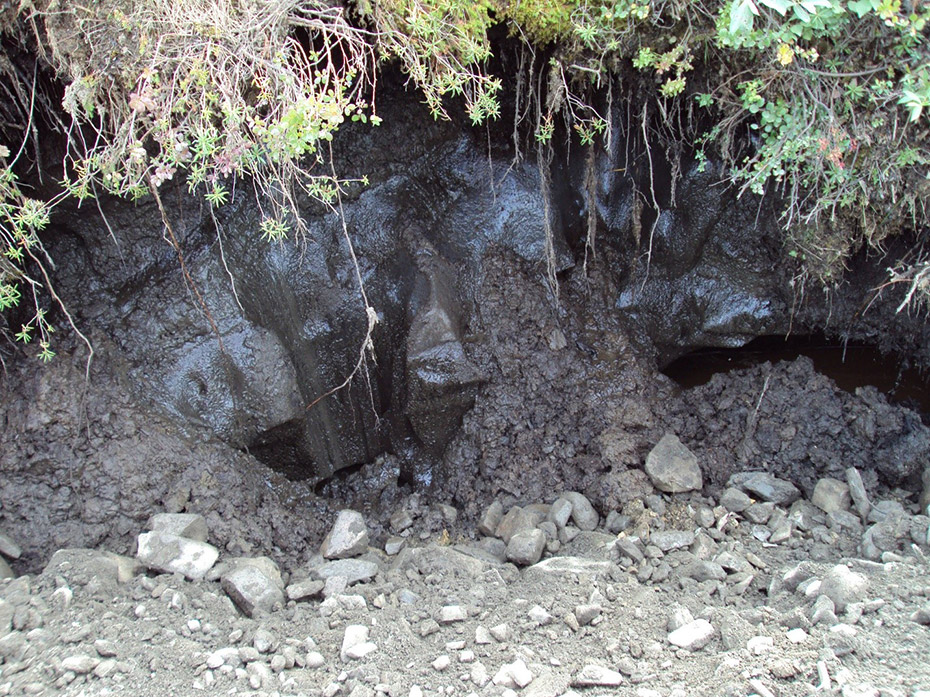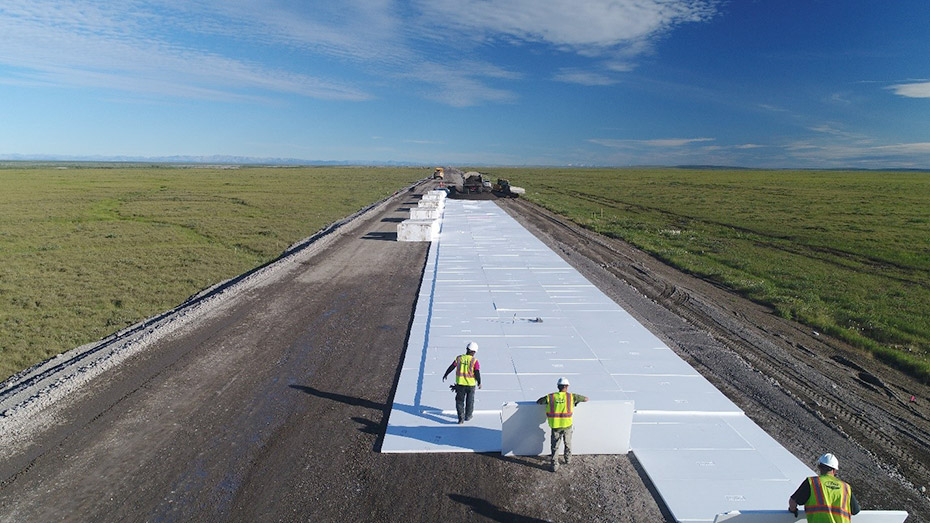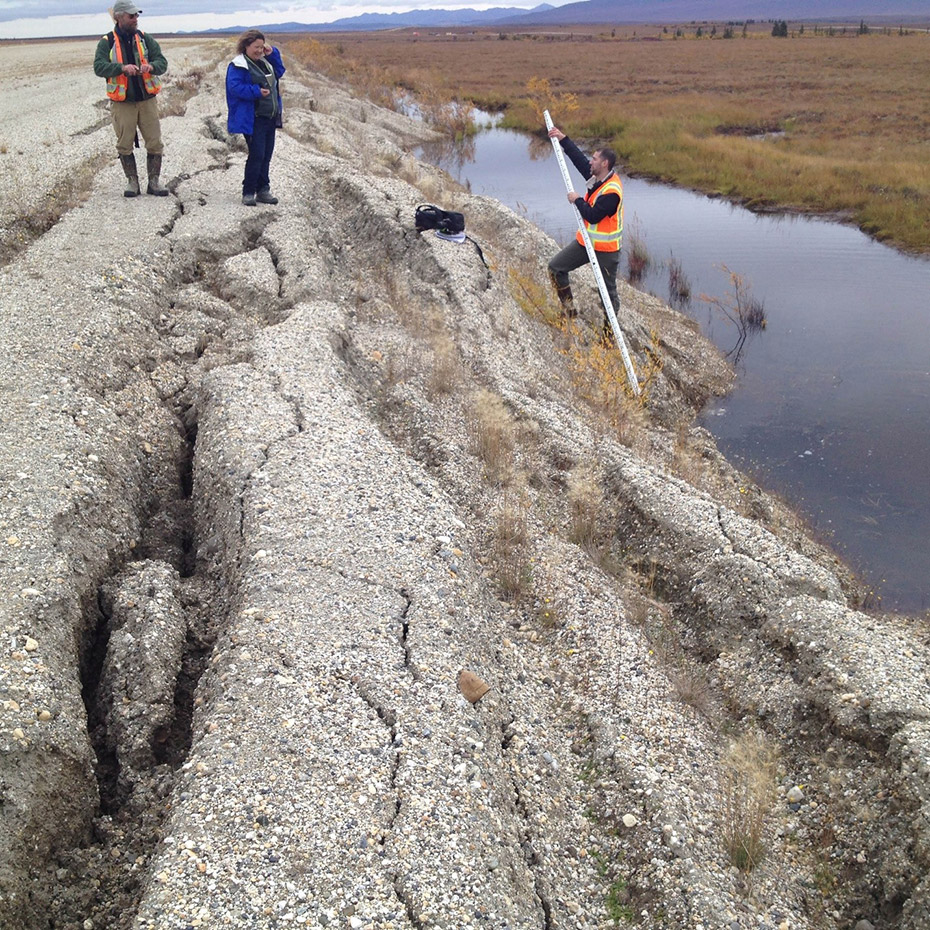Building in Permafrost Country
A challenge of technology, cost, and a warming climate
Here at DOT&PF, we would really like Alaska’s permafrost to stay frozen. There are a lot of reasons why it’s better for all of us that permafrost stays frozen, but for our purposes, it’s because it can cause a lot of damage to our infrastructure when it thaws. The bad news is that one of the quickest ways to thaw permafrost is the build a road on it. Permafrost is ground that remains frozen (that is, it stays at a temperature of less than 32°F or 0°C) for more than two years, and in many cases, for hundreds of years. This article will dive into the types of permafrost we see in Alaska and what we do to manage the infrastructure we build on it.

When ice-rich silty permafrost thaws, it can make beautiful designs, but it causes erosion and settlement on our roads that make for lots of problems for travelers. Photo by Steve Oswald, Alaska DOT&PF
Not all permafrost is created equal
When we talk about permafrost causing problems for infrastructure, we’re really talking about only one kind: thaw-unstable permafrost. When bedrock or river gravel that has been frozen for many years warms up to above freezing, it generally stays in the same place. These are stable materials whether they are frozen or not. Likewise, permafrost that is very cold doesn’t present as many problems. Lots of permafrost on the North Slope, like what you might find in the last fifty miles of the Dalton Highway, is at least as cold as 25°F (or around -4°C). This permafrost can warm up a few degrees and still remain frozen.
The big problem for us is ice-rich, silty material that is right on the edge of frozen. This kind of permafrost is particularly susceptible to thawing when we disturb it to build infrastructure, and when it thaws, it settles and become unstable. Some of the main highway arteries in the state, not to mention essential rural airports, run over thaw-unstable permafrost.

This map shows the likelihood that permafrost will exist in a given area. This map does not show whether or not the permafrost that does exist is thaw-stable or thaw-unstable.
The wedge and the lens
Within permafrost, we also sometimes see ice wedges and ice lenses that cause big problems for our infrastructure when they melt. Ice wedges are thin, sometimes very deep, lines of pure ice wedged into the ground. Their profile looks a bit like a carrot, and they are often covered with a layer of silt or soil on top, which makes them difficult or impossible to see from above. While drilling samples on the Dalton Highway at mile 9, our materials engineers came across ice wedges that were more than 80 feet deep. Ice lenses are similar, but instead of wedged in the ground vertically, they lay horizontal along the ground below the surface.

Erosion along the Taylor Highway exposes ice in native ground adjacent to the embankment. Photo by Jeff Currey, Alaska DOT&PF
Differential settlement and the rollercoaster ride
Whether we’re dealing with ice-rich silty permafrost, ice wedges, or ice lenses, the problems for us start when the thawing causes differential settlement. That means the ground settles, sinks, or moves unevenly. This settling presents a big maintenance challenge for our infrastructure—especially our roads and airports. When you drive on highways damaged by thawing permafrost, you may see dips and waves that make you feel like you’re driving on a rollercoaster. You may also see sinkholes, big cracks in the road or on the shoulders, or pooling water at the bottom of the road or runway embankments. These all can cause problems for travelers and our maintenance forces.
Before we move onto what we do to address and mitigate this kind of damage to our infrastructure, we want to make a quick note about permafrost versus frost heaves. Not all the damage to pavement that you see in permafrost country is caused by permafrost. Another common problem in Alaska and other cold regions is damage due to freeze/thaw cycles. When water gets underneath pavement (either because of cracks in the pavement or due to groundwater that is brought up through wicking in the soils) and then it freezes in the winter, it will cause the pavement to heave up. This is because ice takes up more space than water. When that ice under the road thaws again and drains away, it creates a void under the pavement where there is no longer any materials to support it. After vehicles drive over this pavement, it can dip, crack, and pothole. This is different than permafrost, because the ice that causes frost heaves thaws each year when temperatures warm.
The Impact of Road Construction on Permafrost Stability
Road construction can significantly affect permafrost by disrupting the natural conditions that help keep the ground frozen. It often begins with the removal of trees that provide surface shading and help maintain cooler soil surface temperatures. Depending on the project, this may be followed by the clearing of surface vegetation and moss, which serve as insulation for the underlying permafrost.
Construction typically occurs during the summer, when warmer weather and favorable ground conditions make it the most practical time to work. However, this seasonal timing also increases the ground's exposure to higher air temperatures and solar radiation, which can contribute to thawing. In some cases, excavation may extend below the natural ground surface, exposing deeper soil layers to heat and further disturbing the permafrost.
Finally, once the roadbed is built, it is often surfaced with dark-colored asphalt, which absorbs and retains additional heat. Without appropriate mitigation strategies, these combined changes can accelerate permafrost thaw and threaten the long-term stability of the infrastructure.
How we manage building in permafrost country
Here at Alaska DOT&PF, we have five main strategies to manage the effects of permafrost thaw on our infrastructure:
- Avoid it. If we can, we try to avoid building on permafrost, although that’s not always possible.
- Remove it. If possible, we will dig out the frozen material under the ground and replace it with stable material.
- Thaw it. In some cases—when practical and compatible with construction sequencing—we pre-thaw the foundation soils before building the embankment. This process removes some portion of the ground ice, which in turn reduces the potential for thaw-related settlement after construction is complete.
- Keep it frozen. We have a variety of techniques to keep the ground frozen, and are always experimenting to find new and better methods.
- Accept it. The challenges with the other three options leave us with our last strategy: build over permafrost using traditional construction methods and accept the consequences.
Avoid it
The map at the top of this page shows where we are likely to find permafrost in Alaska. While some areas of the North Slope have reliably continuous permafrost under the ground, many areas of the state have discontinuous, or patches, of permafrost. That means we don’t always know whether or not there is permafrost under the ground or not.
One key to avoiding permafrost is to know where it is. We do that by drilling into the ground and collecting samples. We drill in several different locations, which can tell us about what is under the ground at different points. We hope that these samples can give us a clear view of the whole, but sampling isn’t perfect. Ice wedges, those carrot-shaped ice formations, can be difficult to detect with drilling samples.
We are starting to use other new techniques to get an even better picture of what’s under the ground, including using different types of imaging. These techniques use electricity, magnetics, and radar to “see” what’s under the ground without us having to do any digging.
Remove it
This may seem like the most obvious solution, but it comes with its own set of problems. First, permafrost removal ideally needs to happen in the winter when air temperatures are cold. If you try digging it up in the summer months when it’s warm outside, the ground will thaw and turn into a soupy mess that is extremely difficult to handle and remove.
Next, after you have removed all that frozen material, you’ll need to replace it with gravel. This work ideally needs to be done in the summer when it’s easier to manipulate and work with the fill materials, but if you wait until summer, you get the soupy mess again. And, depending on how much permafrost you had to remove, and in some cases it’s a whole lot of material, filling it with good gravel can be very expensive.
Removing permafrost is an option in some locations and we have done it before. The two main reasons it’s not a solution in all locations are logistics and cost. It is logistically difficult to remove permafrost on a road or runway where long, multi-season closures are not an option. And the cost of removing all the permafrost on long stretches of highway is so expensive that we simply can’t afford it.
Thaw it
Pre-thawing foundation soils presents several challenges. First, it typically requires a project schedule that spans two or more construction seasons to allow enough time to achieve the target thaw depth and remove a significant portion of ground ice.
In some cases, it may also be necessary to preload the thawed or thawing ground to encourage consolidation before embankment construction. However, this adds complexity: the preload material not only provides the required weight to drive consolidation, but it also acts as an insulator. This insulating effect can slow or even prevent further thawing of the underlying soil, making it more difficult to achieve uniform thaw and consolidation. As a result, careful planning is needed to balance the timing and duration of both the prethawing process and the preload application to ensure effective ground preparation.
Keep it frozen
Our engineers at DOT&PF have a handful of techniques they use to keep permafrost frozen under our highways, runways, and buildings. For each solution, we have to balance effectiveness and cost to determine if it’s worth it. We are constantly evaluating the effectiveness of the techniques we’ve used in the past, new possibilities for the future, and how our past solutions may not work as our climate continues to warm.
Thermosiphons
Thermosiphons are pipes that are installed in the ground that aim to bring down the temperature of the permafrost during the winter so it can better withstand summer warming. In the winter, the air temperature is typically colder than the permafrost. The relatively warm permafrost will vaporize fluid in the pipes (usually ammonia or carbon dioxide) and cause it to rise. This vapor gets colder at the top of the pipe, where it is exposed to cold winter air. That causes it to turn to a cold liquid and drop back down. This process repeats and keeps the permafrost colder than it would otherwise be. Colder permafrost is less likely to thaw when air temperatures increase in the summer.
Thermosiphons work well, but they are expensive. They work best to keep the ground under buildings stable, but aren’t a great solution for most roads and runways. The area around runways and roads needs to be free of anything that could cause damage to vehicles and airplanes that run off the road or runway. A bunch of metal pipes sticking out of the ground could turn into a safety issue. Thermosiphons can also be damaged by snow plowing operations, making it even more difficult to place them next to roads and runways.
Air Convecting Embankment (ACE)
When we build a road or runway with an ACE treatment, we place coarse rock under a thin layer of asphalt and also along the road or runway embankment. The coarse rock allows air between the permafrost and the surface to move around. In the winter, the warmer air around the permafrost rises (just like with thermosiphons), hits the cold asphalt, and drops back down. This keeps the permafrost colder than it would be otherwise, which in turn makes it more resilient as temperatures warm in the summer.
Insulation

Construction crews install foam board insulation on the Dalton Highway north of the Brooks Range.
Another technique we use is placing insulation under the road surface. Ideally this would keep the cold below the surface trapped there and keep the summer’s warmth out. The flip side is that it keeps the cold winter out as well, which prevents the cooling that helps to keep the permafrost cold. This technique is best used with colder permafrost like what we find on the North Slope.
Accept it
The final strategy for dealing with permafrost is to build infrastructure using traditional construction methods and accept the consequences. Considering the high costs, logistical challenges, and impracticality of the other strategies, sometimes we do very little to address the issue in construction, knowing that the piece of infrastructure will not last as long and will require constant maintenance.
The amount of damage to pavement and gravel surfaces that we will tolerate has a lot to do with how the piece of infrastructure is used. For example, damage to a runway is much less acceptable than damage to a highway. Damage to a highway is less acceptable than damage to a small local road.
An example of a road that was built with traditional construction methods over permafrost is the Dalton Highway. This engineering marvel was built in a hurry in the 1970s to support the Trans-Alaska Pipeline System with little regard to what was under the surface. The country’s northernmost highway does not have a reputation for being a smooth ride, largely due to degrading permafrost under the surface. The intensive maintenance required on this road has been a big challenge for our cash-strapped maintenance forces, but some of the older areas are beginning to stabilize after decades of thawing.
Although some our oldest highway sections may be stabilizing, that only represents a very small portion of our infrastructure. Overall, in the last 10-15 years, our maintenance costs due to thawing permafrost have increased. The likely cause of this increased thawing is climate change, which will only present more challenges in the decades to come. In 2013, DOT&PF estimated that thawing permafrost contributed to $11 million annually in maintenance costs in Northern Region alone. Our maintenance superintendents report that costs have increased since then.
Looking toward the future
All of the infrastructure projects we build, from bridges to buildings, are designed with a life span in mind. This is called design life. When it comes to keeping permafrost frozen, design life is a big and tricky consideration. Our global climate is warming, and that warming is happening even faster in Alaska. This means the techniques that used to work, many of which rely on cold winter temperatures, aren’t as effective anymore. This could change how long our infrastructure lasts. It is becoming increasingly difficult to keep permafrost frozen.
Our engineers use climate modeling when designing projects that takes into consideration our warming climate, but we still don’t have definitive answers about what our future will look like. Our staff partner with other agencies and institutions to research, track, invent, and improve our construction techniques, but many of the challenges we face are unknown.
Despite a difficult outlook, DOT&PF staff are not standing idly by. Just as the world’s climate scientists help us understand how our world is changing, DOT&PF and our partners in research are figuring out how we’re going to keep Alaska moving through it all.

DOT&PF staff evaluate permafrost degradation damage at Noorvik Airport in 2018. Photo by Jeff Currey, DOT&PF
This website is based on a lecture by Northern Region DOT&PF Materials Engineer, Jeff Currey. The lecture, Climate Change Impacts on Permafrost & Alaska DOT&PF Infrastructure, was presented as part of the UAF Summer Sessions & Lifelong Learning program’s Discover Alaska lecture series in 2020. Watch the lecture below to learn more!
